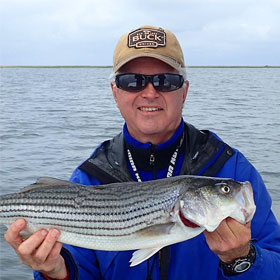How to Use a Baitfish Trap for Saltwater Fishing
By Ken Schultz
Jan 13, 2022
Where and how the author uses an eel trap, minnow trap, and baitfish trap to capture live bait for inshore saltwater fishing, plus how to bait these
Living in a coastal area on a tidal creek, I especially appreciate the ability to deploy a baitfish trap to catch live bait, use that bait to catch assorted species of fish, then recycle the carcasses of those fish to catch more bait and/or to catch blue crabs, which I then eat or also use to catch still more bait or gamefish. It’s an excellent, symbiotic use and reuse of resources, and it starts with the trap(s).
1. Baitfish traps
While I primarily use lures to cast while inshore fishing for striped bass, redfish, spotted seatrout, bluefish, and other species, I’ve especially found success using live bait under a popping cork to catch redfish and seatrout. So, for a decade since I moved from the mountains to coastal Virginia, I set a baitfish trap out from spring through late fall. Sometimes two or three.
2. Catching the Bait
I started out setting an eel trap in order to catch eels. The eel trap is nylon-coated and rectangular, measuring 24 x 10 x 10” with a single, circular entrance at the non-lid end.
I started catching baitfish using a standard wire funnel trap, the kind sold as a minnow trap that has a small conical entrance at either end and which has matching halves that clip together. These caught minnows - killifish or mummichogs - pretty well, whether baited or unbaited.
Larger fish species, including the biggest minnows, don’t enter these smallish traps much. I went through about three per year due to rusting, and eventually stopped using them, although rusting wouldn’t be a problem in freshwater.
With the eel trap sometimes catching eels, but also catching mummichogs, I switched to that for smaller baitfish. Later, I also deployed a square baitfish trap: coated nylon in a 24 x 24 x 12” configuration with four rectangular side entrances. This catches larger minnows, spot, pinfish, pigfish, silver perch, an assortment of bait, and eels. The eels can escape, so when I lift a trap with an eel, I remove it immediately.
The square baitfish trap catches crabs, too. Since I have dedicated large crab traps (which don’t capture bait because of the size of coated nylon webbing), I don’t use the square baitfish trap specifically to catch crabs. When baited, the square trap will attract plenty of crabs as well as baitfish, but when I don’t bait it, I generally avoid crabs and just catch baitfish.
I use both the eel trap and the square baitfish trap simultaneously, and will bait or not bait them according to the amount and type of baitfish I already have or anticipate needing.
One cautionary note: check your state regulations as they apply to gathering and using bait, and what species you may catch that must be released for size or other reasons. And be sure to have a fishing license.
3. What to Bait With
Sometimes the traps will catch baitfish without using bait. Sometimes they won’t catch anything for a while unless baited. For greater production, whole fish or fish carcasses work very well as trap bait. Menhaden and small bluefish are especially good whole; bluefish and trout carcasses work well also, but other fish are certainly acceptable.
In a pinch, or without any carcasses or stored natural bait to use, I may put a can of cat food in a trap. The leftover parts of cooked crabs and other shellfish also serve to catch minnows.
4. Placement and Purchasing
I use traps at my dock where there’s a good current flow. The eel trap gets placed under the dock, preferably next to a piling. The square baitfish trap goes out and away from the dock a few feet, with one siding facing the current (not angled to it). I have no need to place traps elsewhere, but I have a friend who does very well catching minnows with a minnow trap by leaving it overnight at a small drain near an accessible roadway.
There are many different types of fishing bait traps available, including some for shrimp and for specific types of baitfish. Purchasing a trap online may work if you have a clear idea of what you want, but I prefer to purchase a trap that I can look over and see the quality of, paying special attention to whether it is nylon coated, which lasts longer, and how the captured bait will be removed. Some eel traps, for instance, have a small opening on top, which is not as easy to empty as one that has a front end door.









